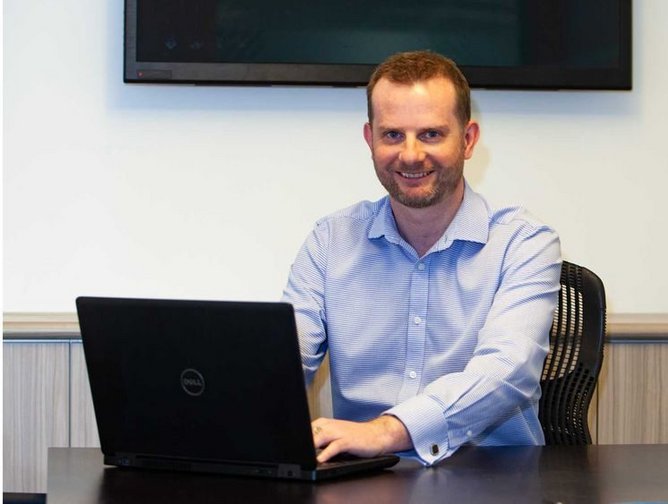The role of the Chief Information Officer (CIO) is one defined by change. For any organisation today, regardless of industry, digital transformation is essential and the adoption of new, innovative technologies forms the core of any future-looking digital strategy. Russell Morris, CIO at Australian electricity network operator TransGrid, is no exception to this. Morris has been at Transgrid for more than two years, joining the organisation to drive its technology transformation, oversee a complex modernisation programme and replace legacy technologies.
Change, however, is unceasing and circumstances out of Morris’ or TransGrid control have made the last 12 months particularly challenging for him and his team. The 2019-20 Australian bushfire season, now colloquially known as the ‘black summer’, saw a period of unusually intense bushfires throughout the country, which only ended in February this year. After those fires, which burned 13 million acres of land on which TransGrid’s vast $6bn electrical asset base resides, there was a brief respite. Then, however, the global COVID-19 pandemic hit Australia and TransGrid like it did every nation and every industry sector.
Understandably, in such circumstances ‘business as usual’ ceases to be relevant. Morris, along with his IT department, were focused on balancing business continuity while still advancing TransGrid, and deriving business outcomes and transformation from any technology investments that were made. Prior to this, Morris had been in the midst of a technology transformation focused on replacing legacy assets with new, digital innovations. The challenges presented by the bushfires and COVID, however, have seen both he and TransGrid refocus their strategy on innovation and technology adoption, as well as the role that both it and the IT team plays within the organisation.
“There’s a really interesting shift in technology moving to being an enabler of a new way of working and a new way of doing things,” Morris explains. “If, as an IT department, you were a technology function pre-COVID you’re now an absolutely essential business enabling function. From our perspective it’s a real evolution in how we’ve approached progress - so, which technologies would be useful, which inform the broader strategy and so forth - and how they will play a completely different function to that we considered six months to a year ago. Take the bushfire as an example. You’d be hard pressed to say that technology alone enabled us to deal with it, but it’s absolutely given us the insight to understand our response to these things, to better realise the importance of data and algorithms, and how we can leverage data from different sources to build a better picture of our operations through predictive analysis.”
Technology has allowed TransGrid to respond to the challenges presented this year in an effective, innovative and agile way, says Morris. He attributes this largely to a major restructure undertaken by his team to align with business ‘domains’. This was needed, he explains, to simultaneously disrupt existing processes, drive value and improve customer experience while reducing costs to serve. “The need was to commit to a next-generation operating model, moving away from the traditional Plan, Build, Run approach. The domain operating model is a new business-aligned way of running the IT function that combines digital technologies with business strategy. There are no longer standalone vertical IT goals. They are instead replaced by business outcomes that are shared horizontally across the business value chain.”
The shift to a domain-type model is beneficial as technology and business functions become more entwined. In essence, in order to maintain pace with this shift in business direction, the operating model employed by the technology function should be more focused on agility, collaborative ways of working and a renewed product and customer focus. Morris adds: “For TransGrid, it has also represented the beginning of a journey to leave behind its legacy single ERP system and replace it with multiple, best of breed cloud based systems, whilst simultaneously implementing a best of breed micro services architecture that allows dynamic data reuse across the enterprise in real time.
“The move to the domain model is relatively common in a lot of sectors, but in utilities it’s rare, we’re really leading the way in that respect,” he continues. “Embarking on such an innovative approach has already revealed opportunities to simplify and streamline journeys and processes that will unlock massive future value. The difference lies in that, instead of sitting centrally - like a hotel concierge that looks to please as many people as possible - it works aligned with distinct domains in the business. There are two distinct parts to the model: the technology and the people or the human element in the business. On the former, we decided to lose all our legacy equipment and use only the very best, tailor-made solutions from the outset, which would then work together under a MuleSoft microservices architecture. This allows for the building of a much more intelligent business based in the cloud - instead of making system constrained compromise, you can have exactly what you need.”
This change has been fundamental in TransGrid’s dealing with the challenges presented by COVID-19, for example. Technology aside, however, Morris is a firm believer in collaboration and the placing of the technology or IT function at the heart of the business, and he is keen to highlight the importance of a collaborative culture across TransGrid. His team’s successful navigating of the COVID challenge has only served to strengthen this trend. “The initial challenge of dealing with the bushfires really built a camaraderie, not only in the IT team, but across the whole business and that was important in how we were quickly able to meet the impact of COVID.
“Before 2020, the highest number of personnel we had working from home in a single day was around 10% of the workforce,” he continues. “This had to rapidly scale to more than 80% now working from home, including the vital training and adoption of collaboration technology. The relationships between the IT domain teams and the other business units were crucial in understanding business needs as circumstances changed very quickly.” An example of this, says Morris, is the establishment of TransGrid’s business continuity kit - an offline information pack that was delivered to the desktops of every computer in the company’s network with important information around working from home. “From conception to agile deployment, it took just under a week to build and played a large part in the overall change management strategy. Our response really grew our reputation and standing within the organisation, and helped to build confidence in us so that we can carry forward the wider technology and business transformation with the full buy-in of everyone involved.”
Crucial to this work, says Morris, is the creation of the new TransGrid IT Ecosystem. This IT vendor ecosystem includes partners such as TCS, Capgemini, Tech Mahindra, IBM and more and will see the sharing of technologies, information and expertise to the benefit of all parties. “It consists of well respected partners that have a symbiotic relationship with us,” Morris explains. “Essentially, it works as a meritocracy where global brands can bring their expertise into the business, working with us to deliver greater business outcomes that would otherwise be possible with just an in-house IT team. Information gets shared reciprocally, and it’s the perfect way to show the power of collaboration. Of course, it’s helped by the broader shift to remote working and the use of new communication technologies - COVID has made the world a lot smaller, and people more available, so we’ve definitely learned new ways to leverage and maximise relationships.”
Thanks to the work of Morris and his team, TransGrid is in a robust position to take any further challenges in its stride. The shift to a new operating model has placed the company in an environment where it is able to maximise the potential of any innovative technologies it implements, while remaining dedicated to the overarching transformation strategy. “We couldn’t predict COVID, but we can now predict what happens when the business is disrupted and how we respond, and I think that gives us a real edge looking further into the future. The challenges and adversity we’ve faced have really benefited our forward-strategy, and I think there is real potential to use technology to create the options and environment for us to do the best work we can - we’re creating the power of choice,” he concludes.




- Russell Morris

